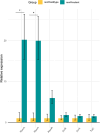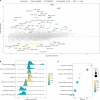Phenotypic and genomic changes in enteric Klebsiella populations during long-term ICU patient hospitalization: the role of RamR regulation
- PMID: 39611855
- PMCID: PMC11656808
- DOI: 10.1128/msphere.00704-24
Phenotypic and genomic changes in enteric Klebsiella populations during long-term ICU patient hospitalization: the role of RamR regulation
Abstract
Acquired antimicrobial resistance and metabolic changes are central for bacterial host adaptation during the long-term hospitalization of patients. We aimed to analyze the genomic and phenotypic evolution of enteric Klebsiella populations in long-term intensive care unit (ICU) patients. Weekly rectal swabs were prospectively collected from all patients admitted to the ICU in a teaching hospital from December 2018 to February 2019. The inclusion criterion for patients was hospitalization for more than 15 days in the ICU without any history of hospitalization or antibiotic treatment for the 3 months prior to admission. Among them, enteric Klebsiella pneumoniae species complex (KpSC) populations were detected. For each isolate, extensive antimicrobial resistance profiles were determined using the disk diffusion method, and the whole genome was sequenced using an Illumina platform. In silico typing methods, such as Multilocus Sequence Typing (MLST), core-genome MLST, SNP typing, resistome characterization and mutation point detection, were applied. During the study period, 471 patients were admitted to ICUs. Among them, 21 patients met the inclusion criteria, and only 5 patients (24%) carried unique and distinct KpSC populations during 2-10 weeks in the gut that as detected at admission and excluding acquisition during the ICU stay. One patient showed a rare ST1563 K. variicola persistent carriage for 7 consecutive weeks, which displayed important antimicrobial resistance phenotype changes in the 2 last weeks. In-depth in silico characterization and RNA sequencing of these strains revealed a mutation within the ramR transcriptional regulator resulting in overexpression of the ramA regulator and decreased expression of acrR, which controls antibiotic efflux. This mutation also impacts tolerance to biliary salts. This study revealed the importance of endogenous colonization of KpSC populations in the gut throughout the patient's long-term ICU stay and highlighted the role of ramR in drug susceptibility.
Importance: The Klebsiella pneumoniae species complex (KpSC) is one of the major causes of nosocomial infections, especially in intensive care unit (ICUs). These bacteria are frequently highly resistant to antibiotics, leading to an increase in morbidity and mortality. The origins of multidrug-resistant KpSC strains isolated from ICU patients are still unclear, with at least two hypotheses of acquisition paths: (i) endogenous KpSC populations that are or became resistant to antibiotics and/or (ii) hospital acquisition of circulating KpSC clones. Genomic changes observed in this study might reveal mechanisms to better adapt to KpSC in the patient's gut in the face of heavy ICU medical care pressure.
Keywords: Klebsiella variicola; RamR; host adaptation; intensive care units; long-term carriage; population dynamic.
Conflict of interest statement
The authors declare no conflict of interest.
Figures




References
-
- Rodrigues C, Passet V, Rakotondrasoa A, Diallo TA, Criscuolo A, Brisse S. 2019. Description of 596 Klebsiella africanensis sp. nov., Klebsiella variicola subsp. tropicalensis subsp. nov. and Klebsiella variicola subsp. variicola subsp. nov. Res Microbiol 170:165–170. doi:10.1016/j.resmic.2019.02.003 - DOI - PubMed
-
- Brisse S, Passet V, Grimont PAD. 2014. Description of Klebsiella quasipneumoniae sp. nov., isolated from human infections, with two subspecies, Klebsiella quasipneumoniae subsp. quasipneumoniae subsp. nov. and Klebsiella quasipneumoniae subsp. similipneumoniae subsp. nov., and demonstration that Klebsiella singaporensis is a junior heterotypic synonym of Klebsiella variicola. Int J Syst Evol Microbiol 64:3146–3152. doi:10.1099/ijs.0.062737-0 - DOI - PubMed
-
- Gorrie CL, Mirceta M, Wick RR, Edwards DJ, Thomson NR, Strugnell RA, Pratt NF, Garlick JS, Watson KM, Pilcher DV, McGloughlin SA, Spelman DW, Jenney AWJ, Holt KE. 2017. Gastrointestinal carriage is a major reservoir of Klebsiella pneumoniae infection in intensive care patients. Clin Infect Dis 65:208–215. doi:10.1093/cid/cix270 - DOI - PMC - PubMed
MeSH terms
Substances
LinkOut - more resources
Full Text Sources
Medical
Molecular Biology Databases
Miscellaneous

